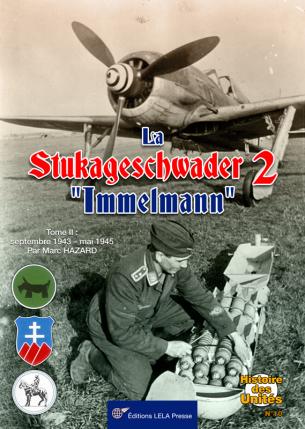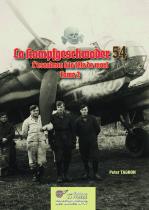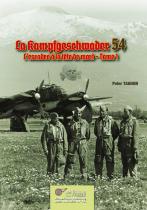After the Battle of Kursk, the German units engaged in the east could only fight obstinately in an attempt to delay the inevitable advance of the Soviet steamroller. Like the other ground support units on the Eastern Front, the Stukageschwader 2 (now Schlachtgeschwader 2) had to adapt and adopt several modifications, the Fw 190 equipping more and more squadrons. But, despite the efforts of the high command, these planes could not completely supplant the ‘old’ Ju 87 who would remain the workhorse of many aces including Hans-Ulrich Rudel. The Ju 87 G equipped with two anti-tank guns was going to cause devastation among the armored adversaries even if they were engaged only in small number and could be piloted only by a handful of "Experts".
This Volume II covers the period from September 1943 to May 1945. It relates the last battles as well as the losses of the 'Immelmann' squadron retreating through Romania and Hungary, called continuously on all 'hot spots' to fill Whatever the breaches of a cracking brow on all sides is worth. This until the surrender of May 8, 1945.
A 160-page book, about 360 photos and 29 color profiles.
We talk about it on the net and in the Press:
- After a particularly successful first volume, this second and last volume was particularly awaited.
Dealing with the period between September 1943 and May 1945, we follow the retirement of this prestigious unit until the end of the 3rd Reich and its capitulation.
The "History of the units" series is richly enriched with photographs allowing to appreciate many details on the machines of the St.G.2 or scenes of maintenance and everyday life on the aerodromes.
29 superb profiles by Eric Schwartz (often full-page) advantageously complete this work, showing a whole range of different markings or camouflages including those used in winter.
The text makes it possible to follow with great precision the course of operations, the losses and victories of the unit.
The very charismatic Kommodore Rudel remains attached to the Ju-87 Stuka until the end. Despite numerous injuries which will go as far as amputation of his right leg after receiving a 40mm shell, he will fly with a prosthesis until the last day of war before being taken prisoner.
The appendices at the end of the work go through the numbers of Ju 87 and Fw 190 known to the unit, the crews as well as the hundred medalists of the Iron Cross, the aerial victories, the commanders of the unit as well that of the prodigious course of Hans-Ulrich Rudel.
Here is the bible in French on this unit, gathering in 2 volumes about 450 pages and 1000 photographs. Highly recommended without hesitation .... © Christophe Verdoux for Master194 / Smal-tracks.org / Fighters.forumactif.com.
- This new production from the Histoire des Unités collection by Lela Presse is therefore the continuation and the end of the study of this German dive bombing unit. Evolving from the Junkers Ju 87 to the Focke-Wulf Fw 190 assault, the Stukageschwader 2 thus becomes the Schlachtgeschwader 2. Volume 2 begins in September 1943 and the main text covers 96 pages of the 160 in the book.
It quickly becomes apparent from reading the book that despite the best efforts of its personnel, the Luftwaffe can do nothing against the steamroller that the Red Army has become. Despite very high scores for destroying enemy armor (among others), nothing will help, and the StG 2 / SG 2 will only retreat, moving from one eastern front to another eastern front, descending to in Romania and through Hungary and Silesia, the birthplace of the most famous pilot of the squadron. The state of mind of the Immelmann fighters is well described as the Third Reich collapses. Including during the surrender to the Americans, for those concerned.
As usual, a precise text is abundantly illustrated with around 360 photographs, some in color, and by around thirty profiles that we owe to Thierry Dekker. Unlike volume 2 of JG 54 Grünherz, the author of which used distinct colors to differentiate the main text from the testimony of the elders, the captions of the photos and the footnotes, here everything is printed in one color. Only the discerning and very knowledgeable reader will spot a few very minor inconsistencies in Allied units and very, very rare typographical errors. We appreciate the presence of maps of the Eastern Front, very useful for soaking up the "exotic" geography of the battlefields, for a Western European.
A large part of the work is therefore occupied by the numerous and copious annexes. Here are the details:
- Known losses of StG 2;
- A list of known serial numbers of the squadron's Ju 87s;
- A list of known serial numbers of the Fw 190 of the SG 2;
- A list of the flight crews with some details for each, sometimes a portrait (in addition to the illustrations already contained in the main body);
- The list of Ritterkreuzträger of the squadron (recipients of the Knight's Cross of the Iron Cross);
- The Ergängzungsstaffel of StG 2;
- A mini-biography of Hans-Ulrich Rüdel;
- A page devoted to aerial victories, but without details of these victories;
- The successive commanders of the Geschwader, the Gruppen, the Staffeln.
The appendix on the famous pilot emblematic of the "Immelmann" is the one in which the author loosens the most and moves away from the factual chronicle that constitutes the work to express value judgments and settling of scores to speckled foil, with words requiring the use of the dictionary to understand all the meaning. It’s a bit of a shame and it could spoil the pleasure of reading this very complete and very successful history, which ends with a bibliography, sources and acknowledgments.
© Jocelyn Leclercq - L'Aérobibliotheque.
- Second volume devoted to the StG2 and not far from being a "Rudel über Alles" because he was one of the engines of this unit during the second part of the war ... and he wrote several works of memories which is useful! As for the quotes, it should be noted that the layout is not as refined as in other works in the series: no color coding of the articles and above all, the many testimonies are not underlined in color (unlike for example to the book on JG 54 where the German testimonies were in green and the Soviets in red). The author has done a lot of research and obtained numerous testimonials ... not just quotes from Rudel's works! (It would have been interesting to know what comes out of combat reports and what comes out of post-war testimony) and it's a shame the layout didn't showcase that.
Here we stay on the Eastern Front throughout the retreat from Russia: so we start in Stalino (now Donetsk in Ukraine) and end in Kitzingen in Bavaria via Romania and Hungary (the absence of a map, except one for the Romanian front, does not help to follow the movement of the unit)
The iconography:
- More than 320 black and white photos: airplanes (60 = Ju 87 mainly G; 31 = Fw 190 F, the rest being mostly photos of pilots)
- 12 vintage color photos
- 27 color profiles
- 1 card
· Appendices: Known Losses, Known Wknummers, Pilot Biographies, H. U Rudel, Unit Staff Officers, Unit Air Victories.
In conclusion: an interesting book, which is easily read: a must-have for fans of Luftwaffe, Rudel or Junkers 87 G ... © Modelstories 2020.
- The second dive bombing squadron of the Luftwaffe, the Stukageschwader 2 had many quality pilots, among which a hundred received the Iron Cross (including the famous Hans Ulrich Rudel). After a first volume devoted to the period going from the pre-war period to the important tank battle of Kursk in 1943, we find them again in September of that year to follow their battles on the Eastern Front until to the surrender of May 8, 1945.
The chronology takes up the main events and operations of the unit against a backdrop of successive defeats and retreat in the face of massive forces, with significant losses in men and airplanes. The Ju 87 Stuka (mainly G in this second volume) are completed by FW 190, Hs 129 and some Hs 123 outdated. All these aircraft models are represented in the form of beautifully crafted color profiles signed Thierry Dekker, who knows the subject well, to complete the plethora of photos and period documents that scroll through chapter after chapter.
As in the first volume, the annexes are worth their weight in gold, with the losses, the commanders of units, the planes, the
Werknummer, decorations and victories. An excellent historic job. © Sam Prétat pour Air-Fan N ° 476.








